Developing regulation of energy efficiency of private sector housing (REEPS): modelling improvements to the target stock - Main Research Report
This report describes how the least energy efficient dwellings in the private sector were identified and how their ratings could be improved by a range of improvement measures. Modelling was used to ascertain the least cost way of reaching different standards, with findings presented on capital costs, fuel cost savings, carbon and energy reductions.
15 Appendix 9: Impact Of Improvements On Two Sample Dwellings
Improving the Energy Efficiency in the Detached Bungalow
15.1 For this detached bungalow, as seen in Chapter 4, 65 different single improvement measures or combinations of measures were assessed. The increases in the SAP score, the reductions in kg of CO2e emissions, and the reductions in SAP fuel bills were plotted against the mean capital cost of the various improvements in Figures 4.2, 4.3 and 4.4 respectively in the main report. The median cost of the improvements assessed for this dwelling (i.e. £5450) and the median change in the respective SAP score (i.e. 43 SAP points), the reduction in Kg of CO2e per year (i.e. 21,604 kg of CO2e), the reduction in £ per year on the SAP fuel costs (i.e. £1,913) were used to define the axes in these graphs, quartering the graph into low cost - low impact, low cost - high impact, high cost - low impact, and high cost - high impact sections. The further left on the x-axis and further up the y-axis, the bigger the impact on the energy performance of the dwelling for the money spent.
SAP rating: Low cost - High impact improvements in the Detached Bungalow
15.2 In terms of the impact on the SAP rating, ten improvements comprised the low cost - high impact sector of the graph in Figure 4.2 in the main report: all involve heating improvements in combination with other improvements. Loft insulation is part of 9 of the packages (see Table A9.1). The cost of increasing the SAP rating by 1 point ranges between £59 and £109 per point amongst this group of improvement packages. Two of the improvements here do not raise the dwelling beyond the SAP Band of G; with the rest, the dwelling would achieve SAP Band F.
Table A9.1: SAP rating: Low cost - High impact improvements in the Detached Bungalow
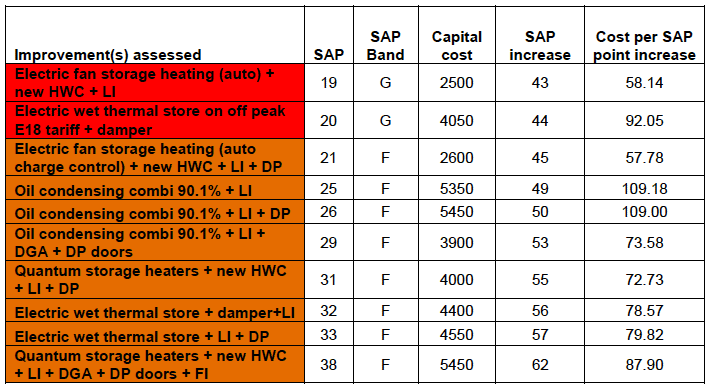
SAP rating: Low cost - Low impact improvements in Detached Bungalow
15.3 The low cost - low impact sector is comprised of 23 improvement options: a variety of insulation measures, new heating without any additional insulation, some renewables on their own, and some insulation combinations. The common factors are that the single measures and packages have an indicative cost of less than £5450, and they do not increase the SAP by 43 points or more.
15.4 The cost of raising the SAP score by 1 point can be extremely high within this group. The cost per SAP point increase ranges from £25 per point (i.e. loft insulation) up to £5000 per point increase (i.e. solar hot water). While the best measure here in terms of its £ per SAP point increase is loft insulation (at a cost of £2 per SAP point increase), its ultimate effect is negligible for the dwelling as it only raises the overall rating by 14 SAP points; the next best improvement (i.e. loft insulation and draughtproofing) only raise the rating by 15 SAP points (see Table A9.2).
15.5 None of these improvement options increase the SAP rating by enough points to raise it into the next SAP banding. Given its very poor SAP score starting point, none of the improvement options increase the SAP rating by enough points to result in an increase in its publically quoted SAP rating.
Table A9.2: SAP rating: Low cost - Low impact improvements in the Detached Bungalow
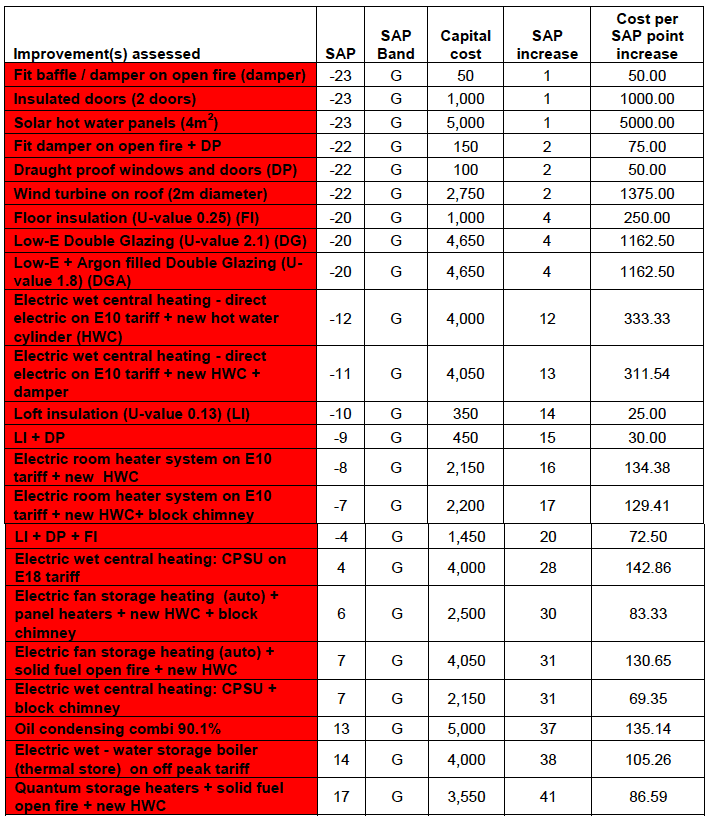
SAP rating: High cost - High impact improvements in Detached Bungalow
15.6 It is not that insulation does not have an impact on the energy rating of this dwelling (see Table A9.3); it has to be packaged. When enough insulation measures are packaged, or coupled with space heating or renewable technologies, significant increases in the SAP rating can be achieved. However, while all of these improvement options achieved more than a 43 point increase in the SAP rating they all cost more than the median of £5450. All the improvement options here achieved at least SAP Band F; some achieved Band E, and even Band D (see Table A9.3).
15.7 The cost per SAP point increase here has much narrower range than seen with the Low cost - Low impact measures. The cost per SAP point increase ranges between £198 per point up to £417 per SAP point.
Table A9.3: SAP rating: High cost - High impact improvements in the Detached Bungalow
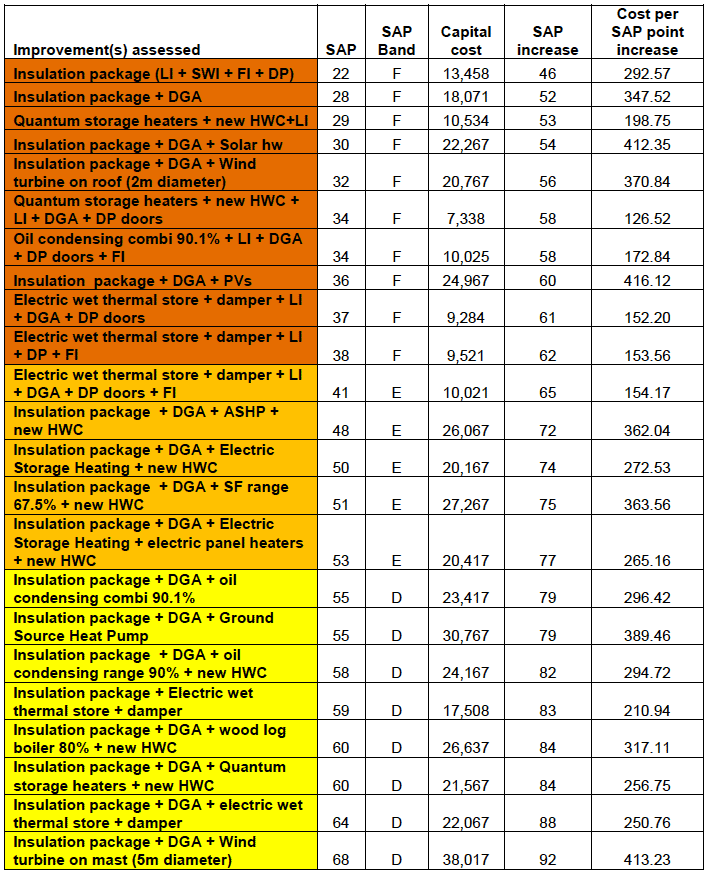
SAP rating: High cost - Low impact improvements in the Detached Bungalow
15.8 Some measures are very expensive coupled with a relatively small gain in SAP. None of these improvement options raised the SAP Banding of this bungalow above its starting level of G, yet each still cost more than £5450. Nine of the improvements fell into this category (see Table 8.4).
15.9 The cost per increase of 1 SAP point ranges from between £151 and £3833, but as seen above these are not as expensive as the cost of increasing the SAP score by 1 point associated with installing a solar hot water system.
15.10 Five of the measures in this group may be eligible for payments under either the Renewable Heat Initiative (RHI) or the Feed-in-Tariffs (FiTs). Neither of these schemes provides upfront financial assistance to install the eligible improvement (so the householder still has to find this investment cost), but the two schemes do make payments to the householder for the calculated energy replaced by the technology, or for the amount of electricity generated, for a number of years into the future, e.g. 20 years under the FiTs.
Table A9.4: SAP rating: High cost - Low impact improvements in the Detached Bungalow
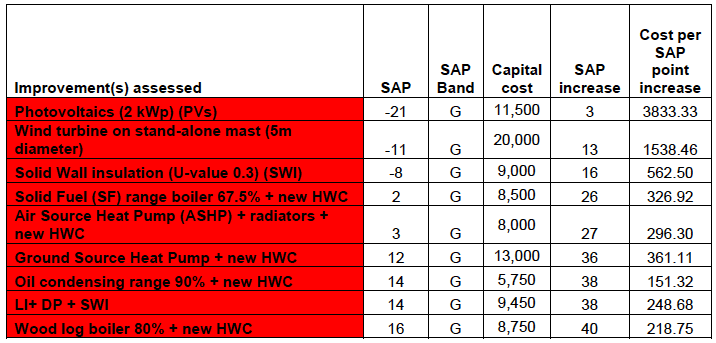
Reducing Carbon Emissions in the Detached Bungalow
15.11 Similarly, the capital costs of the improvement options can be compared with their impact on the annual CO2e emissions from this dwelling (see Figure 4.3 in the main report). The median cost of the improvements is £5450, and the median kg of CO2e reduction per year is 21,604 kg of CO2e.
CO2 emissions: Low cost - High impact improvements in Detached Bungalow
15.12 When examined in terms of the impact on reducing carbon emissions from this dwelling, the Low cost - High impact sector is comprised of heating options. Changing the reliance on burning house coal in open fires will reduce the CO2e emissions from this dwelling. As this dwelling is well off the gas grid, the fuel of choice for many parts of Scottish households (i.e. mains gas) is not an option.
15.13 The oil boiler, quantum storage heater, and electric wet thermal store improvements of the Low cost - High impact measures per SAP point again feature amongst the Low cost - High impact sector when costs are assessed against the CO2e emission reductions (see Table A9.5). While the new high thermal capacity electric storage heaters (i.e. Quantum storage heaters) still feature here, the modern slimline form of storage heating drops out.
15.14 The oil boilers in this section are joined by the condensing combi boiler without any additional insulation being included within the improvement measure. No insulation package comes within this sector (because without a switch of heating they are still modelled with solid fuel and electric room heaters).
15.15 There is a relative degree of consistency in this sector - there is a limited variability in the capital costs (ranging from £3900 up to £5450, and the mean cost of reducing CO2e by 1 kg per year here ranges between 15p per kg of CO2e up to 23p per kg of CO2e saved.
Table A9.5: CO2e emissions: Low cost - High impact improvements in the Detached Bungalow
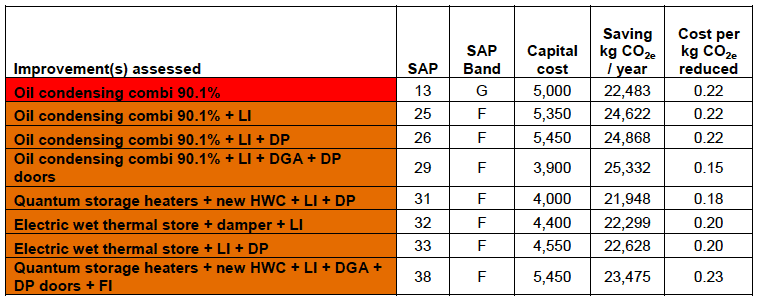
15.16 Loft insulation and draught proofing are joined within the Low cost - Low impact quarter by floor insulation, as well as various heating improvements both with and without insulation in the package, and some of the renewable options (see Table A9.6).
15.17 Again, while loft insulation, on its own and in combination with draught proofing, is very good in terms of its cost per kg of CO2e saved per year, at 5p per kg of CO2e reduction, its overall impact is limited on reducing the total CO2e emissions from this dwelling when compared to the impact of some of other measures in this sector.
15.18 As there is no minimum reduction in CO2e associated with this group, the cost of saving a kg of CO2e per year varies considerably within this group, from 5p per kg to almost £8 per kg of CO2e saved per year.
Table A9.6: CO2e emissions: Low cost - Low impact improvements in the Detached Bungalow
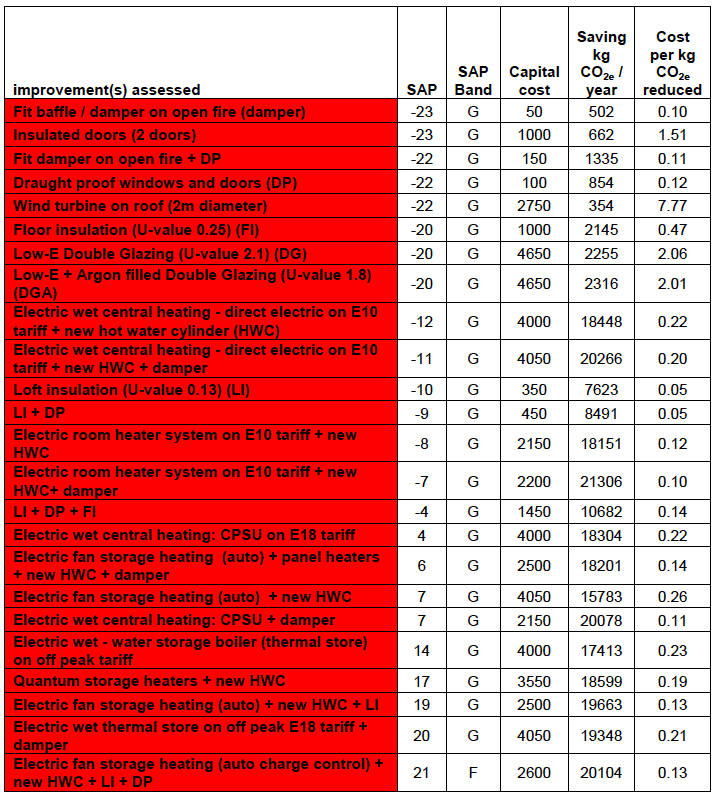
CO2e emissions: High cost - High impact improvements in the Detached Bungalow
15.19 The High cost - High impact quarter is comprised of changes in heating system and various insulation packages coupled with the changes in heating system or with renewables (see Table A9.7). There are no insulation only packages in this quarter.
15.20 While some of these improvements have a significant impact on the CO2e emissions, they do not raise the SAP banding above Band G - various heat pump systems, an oil boiler and the wood log boiler, all without any additional insulation. By contrast other improvement options significantly reduce the CO2e emissions and significantly increase the SAP banding to Band D.
15.21 This group demonstrates a narrow range amongst the costs associated with reducing the CO2e emissions by 1 kg per year, ranging between 22p per kg to £1.44 per kg of CO2e saved.
Table A9.7: CO2e emissions: High cost - High impact improvements in the Detached Bungalow
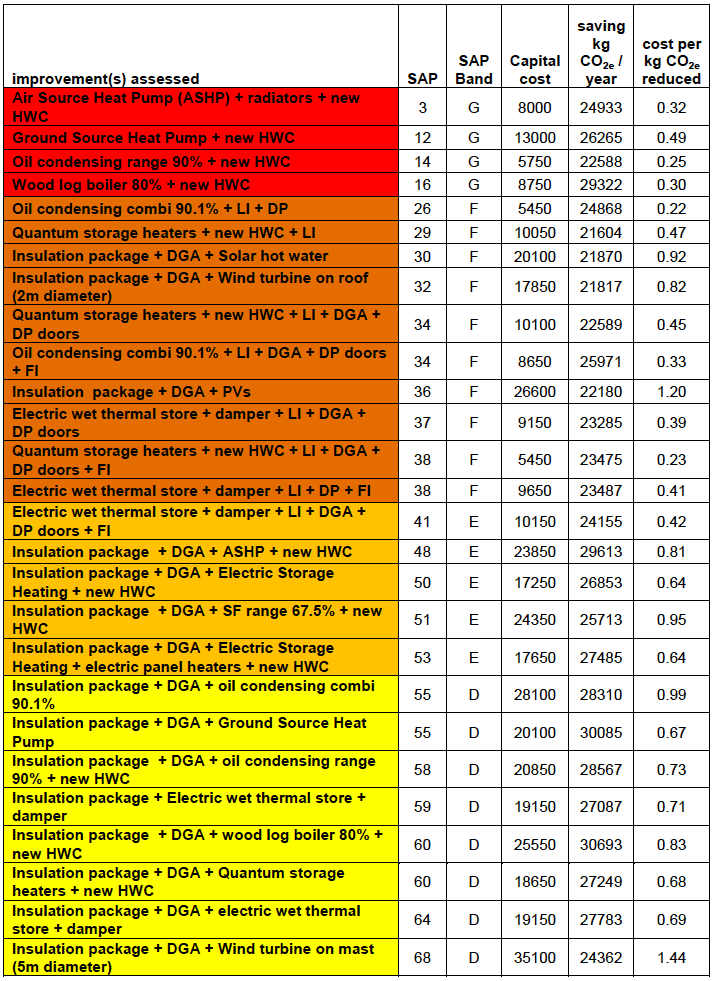
CO2e emissions: High cost - Low impact improvements in Detached Bungalow
15.22 The High cost - Low impact emissions quarter is comprised of the two renewable options without any additional insulation that were also included in the High cost - Low impact sector when costs were plotted against the improvement in the SAP score. On this occasion these options are joined by various insulation packages that include solid wall insulation but without any changes to the heating. Solid wall insulation is expensive, but without also tackling the heating in this dwelling, the carbon savings will be lower than the mean. The impact of the insulation is not enough to overcome the high emissions associated with the existing heating (see Table A9.8).
15.23 The costs per kg of CO2e reduced per year range between 53p per kg of CO2e per year (i.e. for the new solid fuel (i.e. house coal) range boiler - if it burned wood as its fuel then there would be significantly higher carbon savings ) to over £16 per kg (i.e. solar PV panels).
Table A9.8: CO2e emissions: High cost - Low impact improvements in the Detached Bungalow
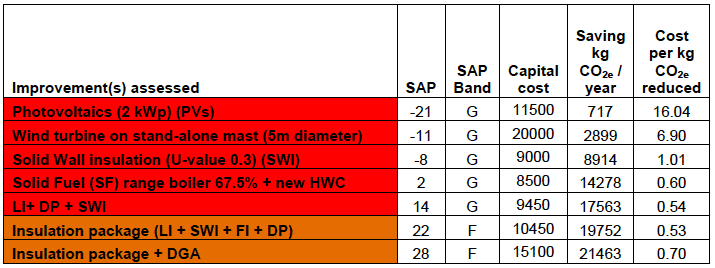
Reducing Fuel Bills in the Detached Bungalow
15.24 The capital cost of the improvement options were compared with the reductions the SAP fuel bills (see Figure 4.4 of the main report). The median cost of the improvements is £5,450, and the median SAP fuel bill reduction is estimated at £1913 per year. As noted in the main report, the SAP scores and SAP fuel bills are directly related, so the improvement measures comprising Low cost - High impact, Low Cost - Low impact, High cost - High impact and High cost - Low impact groupings are identical to those seen when discussing the impact of the improvements on increasing the SAP scores.
Fuel bill reductions: Low cost - High impact improvements in Detached Bungalow
15.25 The Low cost - High impact sector of the fuel bill reductions versus capital costs comparison is comprised of various changes in the heating system usually coupled with loft insulation or loft insulation and draught proofing. The payback periods range between 1.3 and 2.6 years (see Table A9.9). All but two of the improvements here raise the dwelling into SAP Band of F.
Table A9.9: Reduced Fuel Bills: Low cost - High impact improvements in the Detached Bungalow
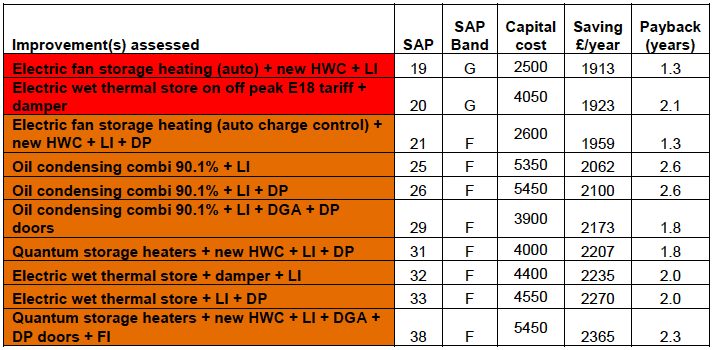
Fuel bill reductions: Low cost - Low impact improvements in Detached Bungalow
15.26 All of the single insulation measures have an impact on reducing the estimated fuel bills, but their impact is relatively low overall without addressing the heating system (see Table A9.10). Some of these options are not 'cheap' to install, although they fall within the low cost range of options for this dwelling.
15.27 The result is the wide variability in the associated payback periods seen in this quarter. The payback periods range from between 6 months (i.e. loft insulation) to over 125 years (i.e. solar hot water system). Despite the very good paybacks associated with many of the improvement options here (e.g. 18 of 32 of the improvement options have simple paybacks of less than 5 years; another 5 have paybacks of between 5 and 7 years), none are sufficient to raise the dwelling above its starting SAP Banding of G.
Table A9.10: Reduced Fuel Bills: Low cost - Low impact improvements in the Detached Bungalow
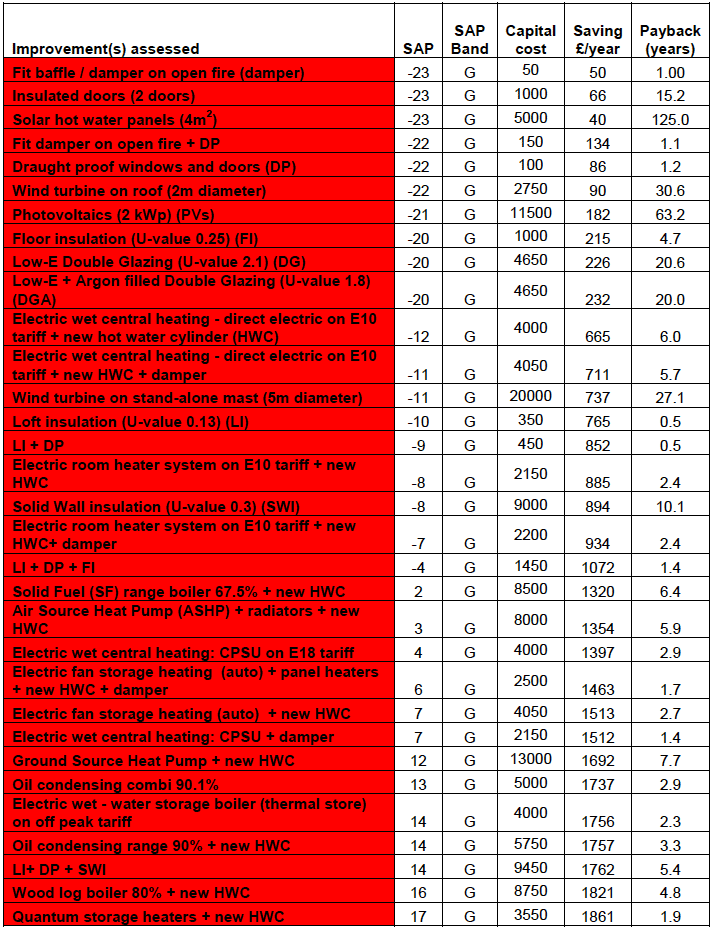
Fuel bill reductions: High cost - High impact improvements in Detached Bungalow
15.28 The largest reductions in fuel bills are seen where the insulation and double glazing package is usually coupled with the improvements in the heating system for this dwelling, or coupled with renewable and low carbon technologies, but these come at a cost (see Table 8.11), thus, being found in the High impact - High cost group.
15.29 However, despite the high costs, the payback periods range between 2.3 years and 11.4 years. Eight of the 25 options here have payback periods of less than 5 years; another 7 have payback periods of between 5 and 7 years.
Table A9.11: Reduced Fuel Bills: High cost - High impact improvements in the Detached Bungalow
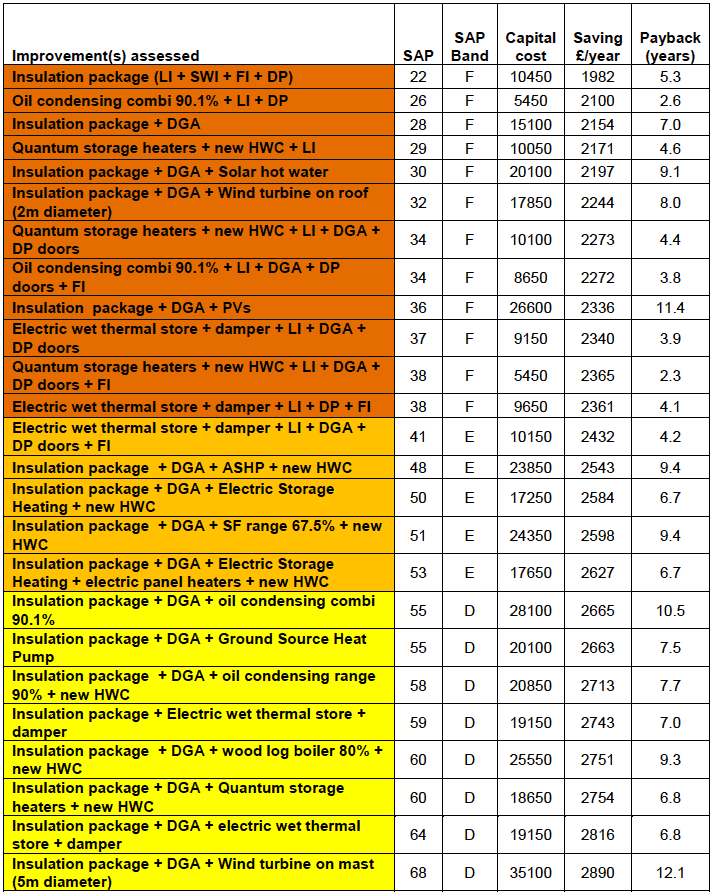
15.30 What is interesting is that amongst the improvements recording the highest impact on the fuel bill, are several variations on electric heating - both an electric wet thermal store heating system and the new, high thermal capacity (Quantum) storage heaters, in conjunction with comprehensive insulation packages.
15.31 The impacts of these packages are such that not only do all of them achieve at least a SAP Banding of F, many will raise the SAP rating to Band E, and even to Band D.
Fuel bill reductions: High cost - Low impact improvements in the Detached Bungalow
15.32 High cost measures do not necessarily equate to large reductions in fuel bills (see Table A9.12). Conversely high capital costs do not necessarily mean long payback periods. The payback periods for the High cost - Low impact improvements range between 3.3 years and 63.3 years.
15.33 This payback does not take account of any benefit of payments that may occur through FiTs or RHI, which, if factored in, would significantly change the payback periods for renewable, heat pump and wood log boiler options that fall within this sector.
15.34 The improvements in this sector are not sufficient on their own to raise the SAP score of this dwelling above its existing 'G' banding.
Table A9.12: Reduced Fuel Bills: High cost - Low impact improvements in the Detached Bungalow
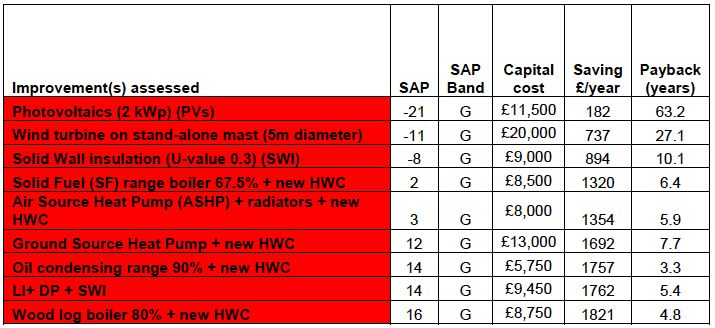
Overall Comment on the Improvements Assessed for the Detached Dwelling
15.35 Many of the measures that make up the low cost - high impact; high cost -high impact; low cost - low impact; and high cost - low impact quarters for this dwelling, regardless of whether assessed on impact on the dwelling's SAP score, the reduction in CO2e emissions, or the reductions in fuel bills, are the same in each quarter. There are a few measures that shift about. From one aspect, that is good in that the same measures would feature in packages whether you tackle fuel bills, CO2e emissions or the SAP score. Within this consistency there is a great variability in some groups in terms of the cost of SAP point increase, cost of saving a kg of CO2e, or the payback period. High cost improvements are not necessarily poor in terms of their impact or their returns; low cost investments are not necessarily good in terms of their impact or their returns.
Improving the Top Floor Tenemental Flat
15.36 Similar analysis was performed on a 1920's solid walled, tenemental, gable end flat within an urban area of Scotland, with 50 separate improvement options (i.e. individual improvements or combinations of individual improvements) being assessed. What emerged immediately was that compared to the detached bungalow off the gas grid, the presence of a gas supply in this dwelling completely changed the dynamics of the improvements. For example, simply fitting a gas condensing combi boiler as a single measure would increase the SAP score from '4' to '55', i.e. in itself raise the SAP Banding of G to Band D.
15.37 The increases in the SAP score, the reductions in kg of CO2e emissions, and the reductions in SAP fuel bills were plotted against the mean capital cost of the various improvements in Figures 4.6, 4.7 and 4.8 respectively in the main report. The median of cost of the improvements assessed for this dwelling (i.e. £3,261.50) and the median change in the respective SAP score (i.e. 41 SAP points), the reduction in Kg of CO2e per year (i.e. 1,970 kg of CO2e), the reduction in £ per year on the SAP fuel costs (i.e. £890) were used to define the axes in these graphs, quartering the graph into low cost - low impact, low cost - high impact, high cost - low impact, and high cost - high impact sections.
Low cost - High impact improvements in Top Floor Tenemental Flat
15.38 Only one measure falls within the Low cost - High impact sector across all performance assessments of improving the SAP rating, reducing CO2 emissions and cutting household fuel costs: the fitting of the new high heat retention (Quantum) storage heaters in conjunction with loft insulation and
draught proofing the door (see Tables A9.13 - A9.15). Modern slimline storage heating system on a 24-hour tariff, coupled with loft insulation, draught proofing the front door, and fitting a new hot water cylinder jacket, show up well on improving the SAP score and reducing the fuel bill, but not so well on reducing CO2e emissions because of the higher CO2e conversion co-efficient with electric heating compared to gas.
Table A9.13: SAP rating: Low cost - High impact improvements Top Floor Flat

Table A9.14: CO2e emissions: Low cost - High impact improvements Top Floor Flat

Table A9.15: Fuel Bill Savings: Low cost - High impact improvements Top Floor Flat

Low cost - Low impact improvements in Top Floor Tenemental Flat
15.39 The Low cost - Low impact improvements (see Tables A9.16 - A9.18) display great variability. Loft insulation, hot water cylinder insulation, draught proofing of the door, and low energy light bulbs are here as single measures, in combined packages, and in combination with various types of electric storage heating. Other improvements common across the various performance assessments are the small wind turbine, and various storage heating systems.
15.40 The cost of improving the SAP rating by 1 point varies considerably, ranging from £19.44 per 1 point increase up to £2,750 (see Table A9.16). Loft insulation on its own is the most cost effective measure in terms of raising the SAP rating; the small wind turbine, the most expensive item.
Table A9.16: SAP Rating: Low cost - Low impact improvements Top Floor Flat
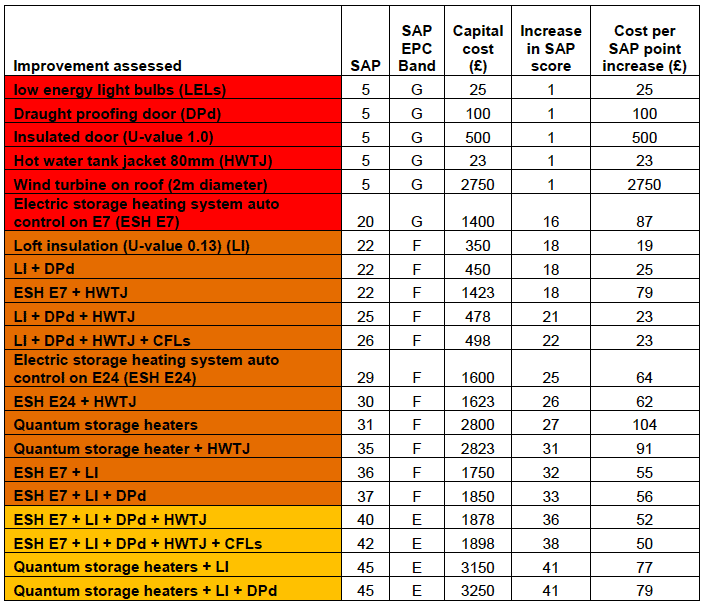
15.41 Unlike the situation within the detached bungalow, both single insulation improvements, and heating improvements without any additional insulation, are sufficient on their own to increase the SAP score enough to achieve Band F (see Table A9.16).
15.42 The cost per kg of CO2e saved per year range from 11p per kg of CO2e saved per year to over £24 (see Table A9.17). The hot water cylinder jacket and the loft insulation are most cost-effective measures here.
15.43 Several of the measures in Table A9.17 actually display a negative impact on CO2e emissions. All of these measures relate to the installation of electric storage heating where no fabric insulation was included in the package (although two of them do include hot water cylinder jackets). Although both direct electric heating and electric storage heating are considered 100% efficient at end use in SAP, storage heating is less responsive than direct acting electric heater, and is therefore penalised within the SAP methodology, so that despite being cheaper to use than direct electric heating, electric storage heating consumes more energy overall and therefore has higher emissions associated with it.
Table A9.17: CO2e Emissions: Low cost - Low impact improvements Top Floor Flat
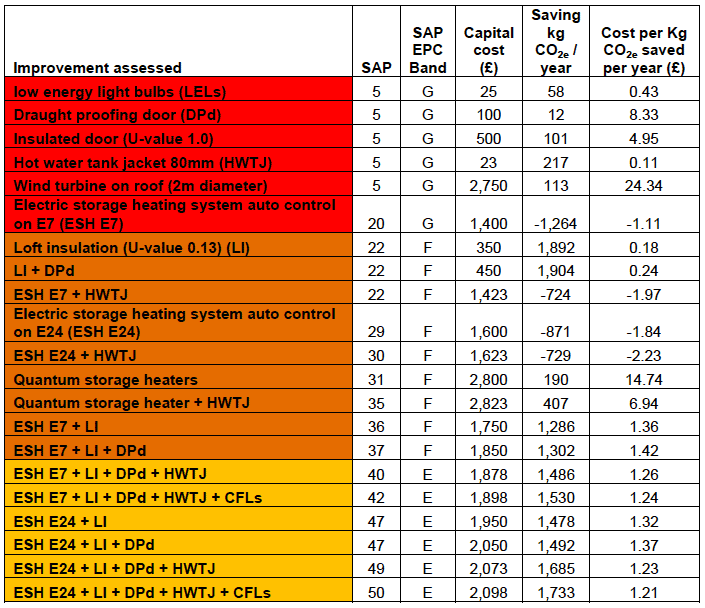
15.44 The payback periods range from less than 5 months to over 94 years (see Table A9.18). Again, loft insulation and the hot water cylinder jacket are at one end of the scale, and the wind turbine at the other. The various electric storage heating systems have payback periods ranging from 2.5 years up to 4 years.
Table A9.18: Fuel Bill Savings: Low cost - Low impact improvements Top Floor Flat
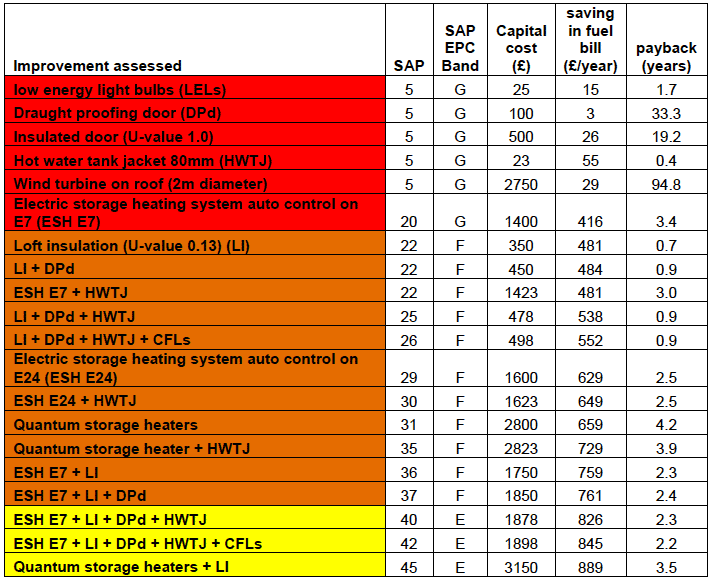
15.45 Even amongst the low impact improvements in Table A9.18, the impact of the majority of improvements here is sufficient to reduce the household fuel bill by more than £10 a week.
High cost - High impact improvements - Top Floor Tenemental Flat
15.46 Amongst the High cost - High impact options assessed for this top floor tenemental flat (see Tables A9.19 - A9.20), the range of measures across the increase in the SAP score and reductions in CO2e emissions and fuel costs are dominated by the ¬comprehensive insulation package either on its own or in combination with a heating system improvement or the addition of renewables. Only two measures here do not include insulation: i.e. a condensing gas combi boiler system as a single measure, or one fitted with flue gas heat recovery (FGHRS). All of these options achieve at least a SAP Banding of E or better; some improvement options achieve Band C.
15.47 The cost per increasing the SAP score here ranged from about £70 per point increase to over £280 per point increase, with the gas condensing combi boiler with loft insulation at the low end, and the comprehensive insulation package with PVs at the high end (see Table A9.19).
Table A9.19: SAP rating: High cost - High impact improvements Top Floor Flat
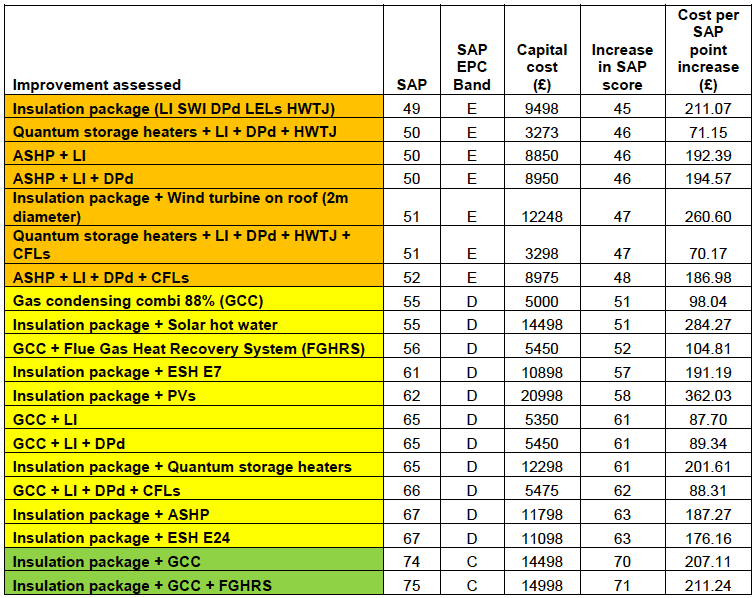
15.48 The cost per reducing CO2e emissions amongst the High cost - High impact measures ranged from about £1.23 per kg of CO2e reduced to over £4.70, with the gas condensing combi boiler in combination with various low cost measures at the low end. The most expensive option with regard to reducing CO2e was fitting the air source heat pump system as a single measure (see Table A9.20).
Table A9.20: CO2e emissions: High cost - High impact improvements Top Floor Flat
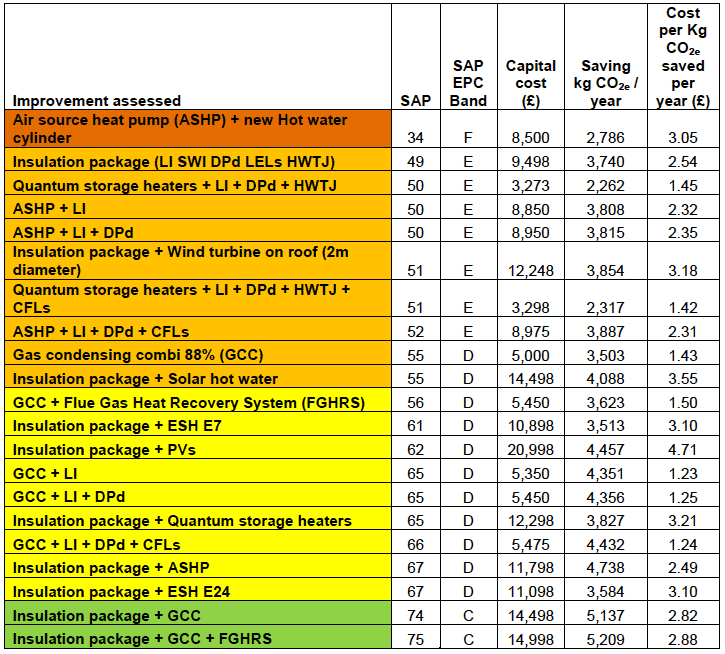
15.49 The payback periods in terms of recouping the capital costs through savings in the fuel bills amongst this sector ranged from 3.4 years to over 18.5 years. The gas condensing combi boiler, in combination with various low cost improvements, is at the low end, and the comprehensive insulation package in combination with the PVs at the more expensive end (see Table A9.21).
Table A9.21: Fuel Bill Savings: High cost - High impact improvements Top Floor Flat
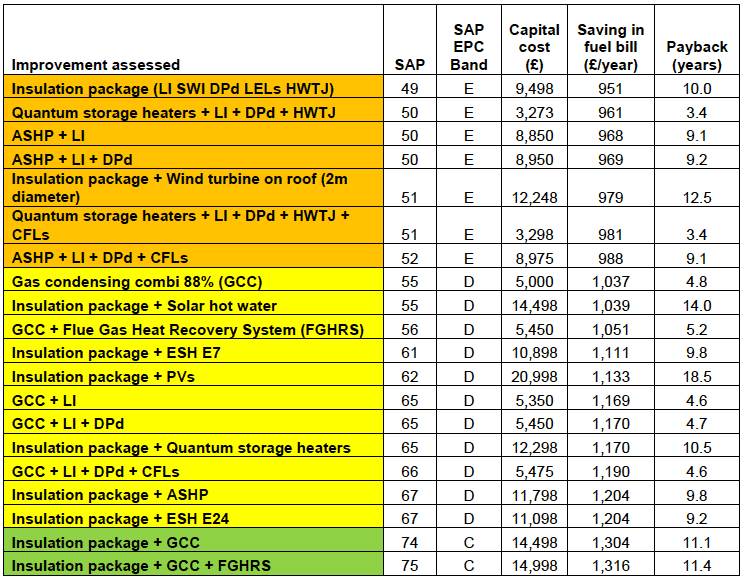
High cost - Low impact improvements - Top Floor Tenemental Flat
15.50 Amongst the improvement options that consistently scored as High cost - Low impact measures in the top floor tenemental flat, regardless of the variable assessed, were the installation of PVs, solar panels for hot water, high performance replacement double glazing and solid wall insulation on its own (see Tables A9.22 - A9.24). The solid wall insulation option was the best performing of these options in terms of the cost per 1 SAP point increase, saving a Kg of CO2e, and payback period; replacing the existing standard double glazing with high performance double glazing was the worst performing option.
Table A9.22: SAP rating: High cost - Low impact improvements Top Floor Flat

Table A9.23: CO2 e emissions: High cost - Low impact improvements Top Floor Flat

Table A9.24: Fuel Bill Savings: High cost - Low impact improvements Top Floor Flat

15.51 The poor financial performance of PVs, the solar panels for hot water, and the air source heat pump here may be different if FiTs and RHI payments were factored into this assessment.
Overall Comment on the Improvements Assessed for the Top Floor Tenemental Flat
15.52 The presence of a mains gas supply changes the fundamental nature of the improvement package compared to the assessment of the detached bungalow which was off the gas grid. Installing a condensing boiler as a single measure would achieve a SAP D Band rating, and in combination with insulation measures could achieve a C rating.
15.53 As with the detached bungalow, there was a general consistency with the measures emerging from the assessment falling into the respective Low cost - High impact, Low cost - Low impact, High cost - High impact, and High cost - Low impact groupings for this property.
15.54 There is also consistency within this dwelling that some measures are extremely cost effective but do not have a huge impact in terms of raising the overall SAP rating. There is also a consistency in measures that are very expensive and do not make a big impact on the rating, or the reductions in CO2e emissions, and have a long payback period.
Overall Comment
15.55 The use of the median values of the capital costs and the median values of the impacts of the different performance variables, i.e. the increase in SAP points, reductions in CO2e emissions and reductions in fuel costs, in these two dwellings defined different thresholds for establishing the low cost - high impact, low impact - low cost, high impact - high cost, and high cost - low impact quartering of improvements for the two properties. They are self-defined by the improvement measures themselves, and by the improvements appropriate to the dwelling; they are not an objective standard. Yet what emerged was the consistency in the measures making up the different quarters, not only for the same property but in the two very different dwellings here.
15.56 Some improvements will always have a low impact; some improvements have a high installation cost. Neither impact nor indicative capital cost on their own define whether an improvement is a good investment or not.
Contact
Email: Silvia Palombi
There is a problem
Thanks for your feedback